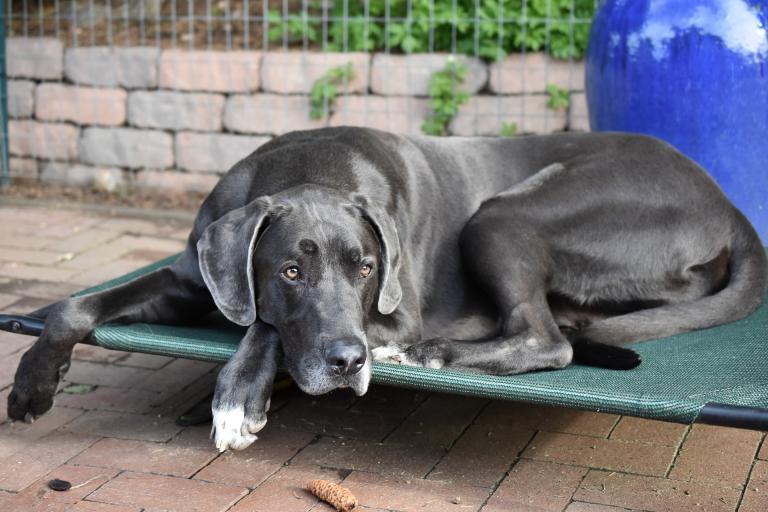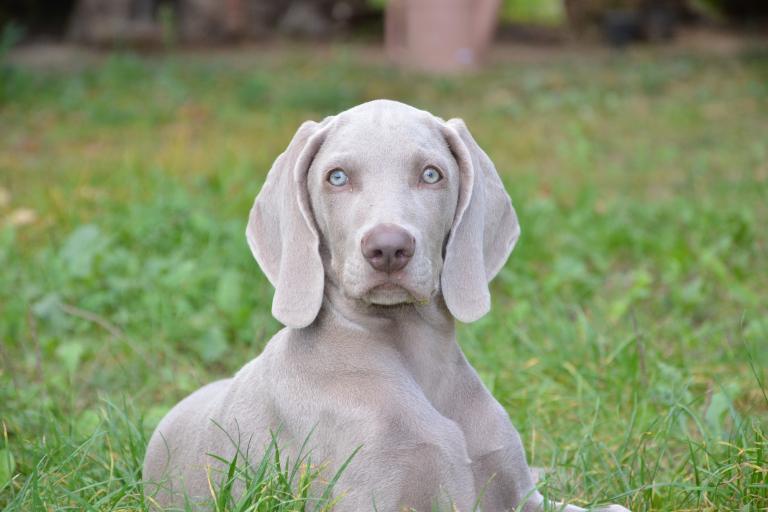Blue/Silver (Coat colour D-Locus Dog)
In the Blue/Silver colour, the dog's coat, but also the skin, have a dark to light grey colour. Depending on the base colour, certain dilution effects of the colour occur.
The recessive d-allele on the D-locus (dilution) causes the optical dilution of the base colour. Here, a mutation-related loss of the MLPH gene leads to disturbances in the pigmentation of skin and hair.
However, the dilution mutation can also lead to severe health problems such as Colour Dilution Alopecia (CDA - dilution colour-related hair loss).
Genetic Test: available in Shop
General Information
- Depending on the base colour, certain dilution effects occur, resulting in a lighter colour of the dog.
- Hair, but also the skin, have a dark to light grey shade with a special shine up to a bluish shimmer.
- The thinning effect is caused by a mutation in the MLPH(melanophilin) gene.
- The gene is involved in the transport of melanocytes, the pigment-forming cells.
- A mutation-related failure leads to disorders in the pigmentation of skin and hair.
- Dilute' animals are very popular among dog buyers because of their special coat colour.
- However, the dilute mutation can also lead to severe health problems.
Associated disease
Colour Dilution Alopecia (CDA - dilution colour-related hair loss)
also known as: BDS (Blue Dog Syndrom)
Symptoms and information:
- Gradual onset of dry, dull and poor coat quality.
- Increasing hair loss is usually most severe on the dorsal part of the body.
- Skin lesions usually develop slowly with age.
- First clinical signs usually occur between 3 and 12 months of age, rarely later in life.
- Histologically, the hair follicles are characterised by atrophy and deformation.
- Heavily clumped melanin is present in the epidermis, dermis and hair follicles.
- Dogs severely affected by CDA have a significantly lower quality of life due to the poor skin condition.
- The severity of CDA depends on the breed:
- In breeds such as the Doberman and Newfoundland, the dilution colour type is prohibited.
- In e.g. Pinscher breeds and Rhodesian Ridgebacks, the reported coat quality in dogs with dilution ranges from normal to severely affected by CDA.
- Breeds such as the Weimaraner do not show CDA despite dilution colour type. Here the dilution colour is even a breed trait.
Test Information
Locus Information: D-Locus
This test shows a non-coding c.-22G>A mutation in the MLPH gene.
Test in Shop
Also in the:
Genotype and Lab Report
Inheritance: autosomal recessive
→ Only animals with two copies of the mutation (dd) have a lighter "diluted" coat colour and are affected by CDA depending on the breed. Animals with only one copy or without mutation do not show the colour.
Genotypes
D/D = Two functional copies
There is no dilution effect, the dog does not have the colour blue/silver.
D/d = One copy intact and one copy non-functional
There is no dilution effect, the dog does not have the colour blue/silver. The d allele for dilution/CDA is passed on at 50%, the dog is a carrier.
d/d = Two copies non-functional
A dilution effect occurs, the dog has the colour blue/silver. The dog can be affected by CDA depending on the breed.
Appearance
Blue/Silver/Anthracite/Grey/Smoke
The dog is dark grey all over the body. The skin around the muzzle and nose also has an anthracite tone. The colouring occurs e.g. in Great Danes or Boarder Collies.
The colour is based on a dark base colour (E/E, E/e) without lightening by the B-locus.
Possible genotypes:
E/* d/d
Lilac/Grey/Silver/Isabell/Beige
The dog is light grey all over the body. The skin around the muzzle and nose also has a light grey tone. The colouring occurs e.g. in Weimaraners.
The colour is based on a dark base colour (E/E, E/e) with lightening by the B-locus (b/b).
Possible genotypes:
E/* b/b d/d
Literature
Welle, M; Philipp, U; Rufenacht, S; Roosje, P; Scharfenstein, M; Schutz, E; Brenig, B; Linek, M; Mecklenburg, L; Grest, Paula; Drögemüller, M; Haase, B; Leeb, T; Dögemüller, C (2009). MLPH genotype—melanin phenotype correlation in dilute dogs. Journal of Heredity, 100(Supplement):S75-S79. https://doi.org/10.5167/uzh-154429
Philipp, U., Hamann, H., Mecklenburg, L., Nishino, S., Mignot, E., Gunzel-Apel, AR., Schmutz, SM., Leeb, T.: Polymorphisms within the canine MLPH gene are associated with dilute coat color in dogs. BMC Genet 6:34, 2005. Pubmed reference: 15960853. DOI: 10.1186/1471-2156-6-34.
Further information is available at Online Mendelian Inheritance in Animals.


